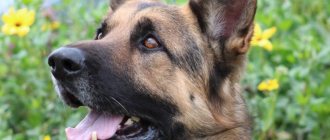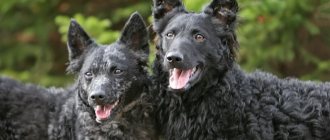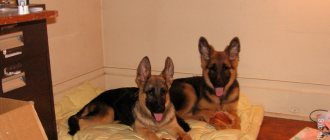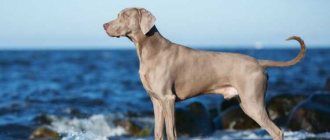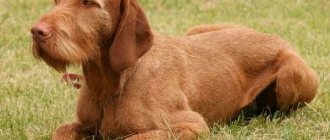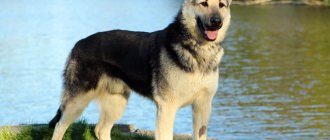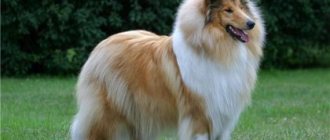| Intelligence: |
| Aggressiveness: |
| For security: |
| For children: |
| Training: |
| Difficulty in care: |
The Basque Shepherd Dog is native to the Basque Country in northern Spain. The dog is not rare. The largest numbers of individuals live in the provinces of Alava, Vizcaya and Guipuzcoa. In its native language the breed is called Euskal artzain txakurra (Euskal artzain txakurra).
Since ancient times, dogs have been used by shepherds to guard and herd livestock. Dog experts believe that these animals originated from Central European shepherd dogs. There are two subspecies of the breed: Gorbeiacoa and Iletsua (lanas). The first live in a reserve near Mount Gorbea, located between the provinces of Alava and Vizcaya. The latter live on pastures in Euskalerria.
The Basque Shepherd was recognized as an official breed in 1995 in Spain. Since then, in the town of Gipuzkoa, shepherds and breeders have held dog competitions to herd sheep, goats and cattle. This event perfectly demonstrates the herding skills of animals. However, the International Canine Federation has not yet identified the Euskal artzain txakurra breed as an independent breed.
Breed standard
The subspecies Iletsua and Gorbeiakoa are not very different from each other. The main difference is the long hair on the Iletsua's face, which forms something like a beard and mustache. In Gorbeiakoa it is short, which does not form any flaws. The sizes of both dogs are almost identical.
The appearance of the breed can be described as follows:
- The height at the withers of males is from 46 to 68 cm, females - from 46 to 60 cm.
- The weight of males ranges from 18 to 36 kg, and for females this range is 17-30 kg.
- The shepherd is large, proportional, with a slightly elongated body.
- The coat is thick and coarse, of medium length, shorter on the front of the paws.
- The color of the animals is red in different shades.
- The muzzle is elongated, narrow, with a black mask.
- Oval eyes of amber or chestnut hue.
- The ears are set high, triangular in shape, and semi-dropping.
- The limbs are strong, of medium length, with dewclaws on the hind legs, and the paws are oval.
- The tail is fluffy, saber-shaped, and droops down.
Euskal artsain txakurra is widespread in Spain. At home, the price of a puppy varies on average from 50 to 250 euros. However, in other countries the breed is quite rare. Therefore, acquiring such a pet is very difficult. You may encounter the problem of not only the high cost of the dog, but also the long waiting time for a puppy.
History[edit]
The Euskal Artzain Txakurra is a traditional Basque breed, and dogs of this type appear in Basque mythology. [1]:536 Similar dogs appear in frescoes in churches and monasteries of the Basque Country from the sixteenth century onwards, and later also in drawings and paintings by artists such as Luis Paret i Alcazar, Gustave Doré and Adolfo Guiard. [1] : 536
The breed was recognized by the Real Sociedad Canina de España in January 1996 with two varieties, Iletsua and Gorbeiakoa; [5] : 440 Gorbeiacoa comes from the Gorbea region, [6] and Iletsua means "hairy" or "shaggy" in Basque. [ citation needed
] It was officially recognized - and the breed standard was published - by the Spanish national government in 2001, initially only for the Gorbeyacoa type; [7] : 21179 Iletsua variant was recognized the following year. [8]: 15116 Additionally, in 2001 the breed in both its variants was included in the official list of autochthonous Basque breeds published by the government of the Basque Autonomous Community; [9]: In 2003, 1,087 specific pieces of legislation were published to regulate breeding and registration. [10]
In 2009, the total number of both subtypes of the breed was estimated to be 500.[1]:536 Although Gorbeiakoa is historically associated with the municipios in the Parque Natural del Gorbeia, both it and Iletsua are distributed throughout the historical Basques. [1] : 536
In the 1950s, some Basques took their shepherds with them when they traveled to the United States to work as shepherds. [eleven]
Dog character
The Basque Shepherd is highly intelligent and quick-witted , making it easy to train and train. Needs early socialization. You should not encourage your puppy to be aggressive towards other animals, as the pet may become uncontrollable.
The dog is sociable and family friendly, devoted to its owner. However, he does not like strangers and is wary of them. Has an active and playful temperament. She is an excellent shepherd and guard. Also suitable as a guide dog for the blind. It is also used to find dangerous objects in search operations.
Links[edit]
- ^ abcdefgh Miguel Fernandez Rodriguez, Mariano Gomez Fernandez, Juan Vicente Delgado Bermejo, Silvia Adan Belmonte, Miguel Jimenez Cabras (editors) (2009). Guía de campo de las razas autóctonas españolas
(in Spanish). Madrid: Ministerio de Medio Ambiente y Medio Rural y Marino. ISBN 9788449109461. - ↑
Mariano Gomez Fernandez (2002).
Las razas de ganado autóctonas vascas en el pastoreo vaso (in Spanish). Annals del Center d'Estudis Comarcals del Ripollès
. 2002: 279–290. - Mariano Gomez, I. Amezaga (2003). Conservation of livestock genetic resources in Euskadi (Basque Country). Animal genetic resources
/
Resources génétiques animales
/
Recursos genéticos animales 33
: 41–55. ISSN 1014-2339. - [sn] (January 11, 2010). Programa de Desarrollo Rural del País Vasco 2007–2013 (in Spanish). Eusko Jaurlarica / Gobierno Vasco. Nekazaritza, Arrantza eta Elikagai Saila / Departamento de Agricultura, Pesca y Alimentación. As of July 2020
- W. J. Avila, M. Gomez, E. Gonzalez Txabarri (1998). Variabilidad de células sanguíneas mediante lectinas fluorescentes en la raza canina Euskal Artzain Txacurra (in Spanish). Archivos de zootecnia 47
(178–179):439–443. ISSN 0004-0592. - ^ ab Perro de Pastor Vasco (Euskal Artzain Txakurra (a variety of Gorbeiakoa or from Gorbea). Real Sociedad Canina de España. Archived October 23, 2022.
- ↑
(May 25, 2001).
Real Decreto 558/2001, de 25 de mayo, por el que se regula el reconocimiento oficial de las organaciones o asociaciones de criadores de perros de raza pura (in Spanish). Boletín Oficial del Estado 142
(June 14, 2001): 21156–21182. Reference: BOE-A-2001-11347. - ↑
[Ministerio de Agricultura, Pesca y Alimentación] (April 17, 2002).
Orden APA / 880/2002, de 17 de abril, por la que se actualiza el anexo del Real Decreto 558/2001, de 25 de mayo, por el que se regula el reconocimiento oficial de las organaciones o asociaciones de criadores de perros de raza pura (in Spanish). Boletín Oficial del Estado 98
(24 April 2002): 15116–15117. Reference: BOE-A-2002-7770. - Ibarrech Markuartu (December 26, 2001). N ° -429: Decreto 373/2001, de 26 de diciembre, sobre razas animales autóctonas vascas y entidades dedicadas a su fomento (in Basque and Spanish). Euskal Herriko Agintaritzaren Aldizkaria
/
Boletín Oficial del País Vasco 14
: 1080–1087. - Gonzalo Saenz de Samaniego Berganzo. (December 9, 2003). No. -201: Orden de 9 de diciembre de 2003, del Consejero de Agricultura y Pesca, por la que se aprueba la reglamentación específica de la raza canina Euskal Artzain Txakurra . (in Basque and Spanish). Euskal Herriko Agintaritzaren Aldizkaria
/
Boletín Oficial del País Vasco 9
(15 January 2004): 741–750. - Ernest Hartnagle and Jeanne Joy Hartnagle-Taylor (2007). Vanished Trials and Faded Memories of Australian Shepherd History. American Kennel Club. Archived from the original on April 30, 2022.
- Perrot de Pastor Vasco (Euskal Artzain Txakurra) (Iletsua variety). Real Sociedad Canina de España. Archived from the original on October 23, 2018.
- Ramona Zallo, Armand Mattelart (2007). Basques, Today: Culture, History and Society in an Age of Diversity and Knowledge. Irun: Alberdania. ISBN 9788496643598.
Choosing a nickname for a pet
The Basque Shepherd is a serious dog that performs important tasks. Therefore, it is worth choosing an appropriate nickname. There is no need to call a dog by a human name.
There are such tips when choosing a nickname for a shepherd:
- The name should be chosen short (preferably two syllables) so that it is convenient to use during training;
- The nickname should not be consonant with the names of the teams so that the dog understands you correctly;
- The name must be clearly and clearly pronounced by the owner, then the animal will know that it is being addressed.
The boy can choose one of the following names:
- Agate, Iron, Ali, Almaz, Arco.
- Baron, Barry, Bart, Ben, Bim.
- West, Wolf, Willie, Vince.
- Hector, Duke, Gert, Grant, Count.
- Jeff, Jones, Dick, Dingo, Dave, Dexter.
- Zach, Zeus, Zapp.
- Karat, King, Cliff, Carl, Kurt.
- Lear, Lord, Larry, Logan, Lance.
- Marcus, Marcel, Martin, Mitch.
- Nathan, Niko, Neis, Nero.
- Opal, Orestes, Oscar, Austin.
- Pierce, Prince, Perseus.
- Ralph, Rick, Rocky, Romeo, Rambo.
- Samur, Sokol, Sander, Sid.
- Tyson, Thor.
- Flint, Fred, Frank.
- Hanko, House, Hunter, Hank.
- Eddie, Eric, Ernie, Elton, Emir.
The following nicknames are suitable for girls:
- Aina, Ira, Alma, Agata, Adele.
- Bella, Bertha, Bagheera, Britta.
- Vega, Valda, Viva, Vilma.
- Glory, Goldie, Greta, Hera.
- Delia, Jenny, Jessie, Diva.
- Kaira, Carla, Katie, Krista.
- Lana, Laura, Leah, Linda.
- Mira, Mirta, Mona, Margot.
- Nyxa, Nura, Nova.
- Paula, Petra, Palma.
- Roxy, Rhona, Rhonda.
- Sabina, Cindy.
- Tiara, Trina, Taiga, Tina.
- Flora, Fraya, Friga.
- Hilda, Holly.
- Angie, Effie, Eira, Helen.
Basic moments
- One of the main distinguishing features of the Basenji is that it practically does not bark. Legend has it that one day the leader of a pack of “creatures from the bush” (as these dogs are also called in their homeland) accidentally learned an important secret that was kept by one of the native tribes. Realizing that he might let it slip, he and his flock swore an oath to the people to remain silent forever. Since then, Congo Terriers communicate with each other and with people, using purrs, snorts, sighs, sounds reminiscent of a strangled laugh or grumbling under the breath of a dissatisfied person.
- Characteristic external signs include a wrinkled forehead, especially when the dog is interested or excited, and a tightly curled tail.
- Basenjis are social animals, accustomed in natural conditions to pack life, so they get along with other dogs, although they also highly value a person’s good attitude, sincerely becoming attached to their owner.
- Representatives of the breed are very active, distinguished by a lively mind, amazing ingenuity and independence. It is impossible to take control of their hunting instinct - the bush dog (another of the many names for the Basenji) without hesitation begins to chase everything that moves. The best means of control is a long, strong leash.
- Surprisingly, the “basya” not only does not bark, but also has almost no smell. But for all their cleanliness, these dogs do not like water. Perhaps their genetic memory contains stories of complex relationships with African crocodiles. There is no need to bathe Basenjis; they handle hygiene themselves, washing themselves like cats.
- The contrast in the dog’s behavior at home and on the street is striking. They love to sleep and in the apartment they behave “quieter than water, lower than the grass.” But on a walk he is an irrepressible bundle of energy.
- African by origin, Basenjis do not like and do not tolerate cold well. Therefore, you should purchase the necessary wardrobe items for walking in winter. Also choose a warmer place in the apartment for your pet.
- As for training, only partnership relationships are possible here. Forcing, imposing your will simply will not work. Therefore, experts do not recommend starting dog breeders to have representatives of the breed. The “creature from the bush” is not suitable as a first dog.
- The Basenji is still a very rare and therefore expensive breed in our country. The decision to purchase just such a pet should be made only after carefully weighing all the pros and cons. Only in this case will you be able to build the right relationship, receiving as a reward an amazingly loyal and intelligent friend.
The Basenji is an animal that came to us from the very heart of the African continent. The breed was formed without any human intervention. All character traits, demeanor, the ability to think quickly, natural ingenuity, and even the love and affection for humans typical of other dogs are the result of natural selection, and not of any breeding experiments. This is the main value of the Basenji, and one must learn to accept, understand and love this creature the way nature created it. This amazing dog is still very rare in our area, but the popularity of the breed is constantly growing.
Pet care and nutrition
The animal is not suitable for living in an apartment. It is best to keep him in a private home with a yard large enough to allow him to run freely without a leash. Needs long walks and other physical activity. The coat should be regularly brushed once a week.
The dog is unpretentious in food. However, it is better to provide her with a complete and balanced diet, including lean meat, cereals, vegetables and dairy products. Ready-made canned and dry food should be chosen only of high quality.
Features of Shepherds
The group of “shepherd dogs” is divided into three subspecies: small, medium, large. The latter is more typical for Asian countries, where breeds have not been subjected to selective selection. Dogs are considered endemic representatives of the ancient Canidae. It is believed that the most characteristic features of Shepherd Dogs are the following characteristics:
- Superbly developed intelligence, comparable to human abilities.
- They are distinguished by determination, natural anger and at the same time are able to control their actions.
- They have fearlessness and are not afraid to go into battle.
- They know how to protect themselves and others.
- They prefer to be close to a person.
- They quickly learn commands and tricks.
- They have excellent knowledge of the terrain.
- They have increased physical endurance.
Due to their natural adaptability, shepherd dogs tolerate any weather conditions well. All representatives have an elongated nose for a better sense of smell, and sensitive hearing, which helps to hear better. A developed sternum and a toned torso make representatives of shepherd dogs maneuverable. The pushing characteristics of the paws and muscles help to jump high and run over mountainous terrain.
